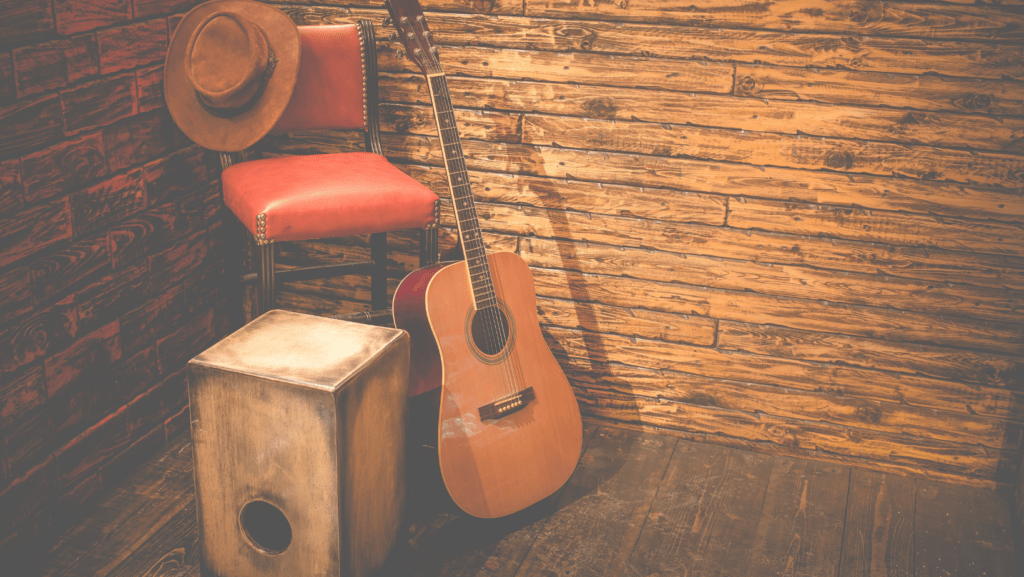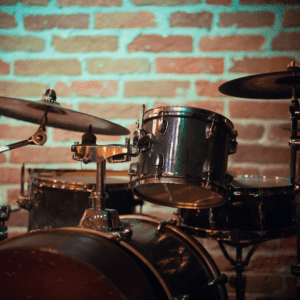
The cajon is a simple, traditional and effective percussion instrument. The word ‘cajon,’ means box or drawer in Spanish. It’s a popular instrument in many genres of music. You can find it played by musicians both on the streets and in studios across the world. Modern times have seen musicians and makers striving to increase the musical possibilities of the cajon and trying to bring its range closer to that of the drum kit.
One recent innovation that is gaining popularity is the cajon pedal. The cajon pedal allows the musician to play a bass note on the cajon with their foot whilst freeing up one of their hands. The cajon pedal can also be a good tool for those percussionists who may want to move on to learning the drum kit at a later date.
Let’s look at some of the best cajon pedals on the market currently.
- Best Top Pick Cajon Pedal – Meinl Percussion TMSTCP Direct Drive Cajon Pedal – A durable direct drive pedal with adjustable spring tension and a soft beater.
- Best Affordable Cajon Pedal – Ortega Guitars Right-Foot Cajon Pedal – A fully adjustable and affordable cajon pedal with a cable mount. You can play it with either your toes or heels. It’s portable and comes with a carry bag.
- Most Portable Cajon Pedal – Drum Workshop DW DWCP5000CJ 5000 Cajon Pedal – A compact and transportable pedal with glide track technology. It’s easy to play at any speed and comes with a carry case.
- Best Direct-Drive Cajon Pedal – ChromaCast CC-PS-DDCPDL Pro Series Direct Drive Cajon Pedal – A solidly built direct drive pedal with outstanding response. It has an inbuilt tool slot for rapid adjustments during a performance.
- Best Cable-Drive Cajon Pedal – Gibraltar G3GCP Cajon Pedal with Mount – A highly adjustable pedal that you can also use with a bass drum.
- Best Heel-Activated Cajon Pedal – Meinl Percussion Direct Drive Heel Activated Pedal – A cradle mount design pedal that you can play with either the heels or the toes. Comes with a soft beater.
6 Best Cajon Pedals Reviewed
Our Top Pick Cajon Pedal Meinl Percussion TMSTCP Direct Drive Cajon Pedal
If you move around a lot or are quite prone to breaking fragile things, then a cable-drive cajon pedal may be a no-go for you. If that’s the case then there are other options for you to try. One such example is the Meinl Percussion TMSTCP Direct Drive Cajon Pedal.
Meinl is well known in the world of percussion and this cajon pedal is a good inexpensive option if you’re not sure if it’s right for you. In terms of performance, the direct drive can cause a bit of lag, but it’s hardly noticeable due to the quality of the build. It’s made to fit all kinds of cajons, from large to small.
The stability is faultless and the hit area is smaller than that of a large kick drum. The beater is soft, which can help ease you into achieving a smooth yet distinct bass tone on your cajon.
Pros
- Not as fragile as some of the cable-driven pedals out there.
- Soft beater for a great bass sound.
- Sounds construction throughout.
- Adjustable spring tension.
- The cradle mount fits most cajons.
Cons
- Some complain it’s not suited for smaller cajons.
- There is some minor playback lag.
Best Affordable Cajon Pedal – Ortega Guitars Right-Foot Cajon Pedal –
The Ortega Guitars cajon pedal is a versatile little pedal. It offers great affordability, quality, and playing options. Its versatility comes from the fact that you can play it with either the heels or the toes. Some reviewers even mention it’s easy to configure for left-foot playing too.
The Ortega cajon pedal is chain-driven and provides extreme responsiveness. This makes advanced playing possible. The cradle mount system means you can fit any cajon without trouble. Don’t let the appearance of the Ortega cajon pedal fool you, it’s sturdy as you could want.
The chain drive on this model is its main selling point, as it allows you to execute smooth grooves without any lag. You can also adjust the tension on the beater depending on your playing style, the genre of music you’re playing, or the venue you’re in.
Pros
- Chain-driven with a cable mount that fits most cajons.
- Adjustable to suit your needs.
- Affordable.
- Comes with a carry bag.
- Designed for both heels and toes.
Cons
- The beater takes up quite a bit of room, minimizing the area your hand can play.
Best Portable Cajon Pedal – Drum Workshop DW DWCP5000CJ 5000 Cajon Pedal
What makes the Drum Workshop Cajon Pedal stand out is the glide track drive technology it has. This technology gives it a punchy sound reminiscent of a bass drum pedal. It’s compact enough to transport easily and also comes with a handy carry bag.
This model can handle whatever your desired playing speed is thanks to the glide track wheel and the double-link pedal. It also boasts the benefit of being easily configured to suit those who prefer to use their left foot. The build is of high quality. It’s a bit of an investment due to the somewhat high price. Yet, you can rest assured that the cable isn’t flimsy and shouldn’t break easily.
Pros
- Has glide-track technology.
- Easy to play at any playing speed.
- Compact and easy to transport.
- Comes with a carry bag.
Cons
- Slightly expensive.
Best Direct-Drive Cajon Pedal – ChromaCast CC-PS-DDCPDL Pro Series Direct Drive Cajon Pedal
The ChromaCast CC-PS-DDCPDL Pro Series Direct Drive Cajon Pedal is a great choice for those who don’t want to run the risk of their pedal breaking or slipping when playing. Quick response, functionality, and strength are at the heart of the design ethos behind this model. It’s also designed to give the same feel as a bass drum pedal, which is good news for those looking to cross over.
The durable steel construction is sure to hold up to rigorous playing and touring. The dimensions are well suited for playing in smaller venues. You can adjust the pedal during performances, thanks to the inbuilt slotted tool holder for a drum wrench and an Allen key.
Pros
- Durable steel construction.
- Direct drive pedal for quick response.
- Resistant to breaking easily and slipping during performance.
- Slotted tool holder for adjustments on the fly.
Cons
- Some people claim they had to make some adjustments out of the box.
Best Cable-Drive Cajon Pedal – Gibraltar G3GCP Cajon Pedal with Mount
Gibraltar is a well-known and regarded manufacturer of hardware. They have a large number of different pedals and mechanisms to suit different players. The G3GCP is useful due to its adjustability. You can adjust springs on both sides of the gear so you can set how much resistance you want. You can also adjust the height of the pedalboard.
Some drawbacks are that you will need to get a separate mount. The cable is very sensitive and can break if played at the wrong angle. But, if you treat it with care this shouldn’t be too much of an issue. Another benefit is you can also use this pedal with your bass drum, which opens up a whole other set of rhythmic possibilities for you.
Pros
- The direct-drive system makes very little noise.
- Quality materials.
- Adjustable to suit your needs.
- Can be used with your bass drum.
Cons
- The cable is a bit delicate and needs to be handled with care
- The beater can be quite quiet.
Best Heel-Activated Cajon Pedal –Meinl Percussion Direct Drive Heel Activated Pedal
For those who are more comfortable playing with their heel, the Meinl TMSTCP-2 should fit the bill. With sturdy and reliable construction, this model will fit an average-sized cajon with its cradle-like mount.
Another reason why this pedal is so useful is because of its versatility. It can be played with the toes as well as the heels, giving you more chance of warding off fatigue when jamming. Another feature that entices many players to this model is the soft foam beater. It’s designed to produce a deep and rich bass note from about any cajon out there.
The simple and unfussy design of this model makes it a good choice and its affordable price is sure to be another selling point.
Pros
- Can be played with the heel or the toes.
- A soft foam beater produces an enviable sound.
- Cradle mount design.
Cons
- The mallet can’t be moved down, meaning if it’s too big, there’s no chance of adjustment.
Cajon Pedal Buying Guide
History Of The Cajon
The earliest examples we have of the cajon (which means drawer or box) being used as a musical instrument was in 19th century coastal Peru at the time of Spanish colonization. This was a time when African slaves had the playing of their instruments banned by their masters.
The slaves, undeterred by the ban turned to ingenious methods to harness the power of their music and rhythms.
Cities on the Peruvian coast had an abundance of crates, drawers, and the like, which we turned upside down and used to tap out the rhythms of their homes by the enslaved. This is the birth of the most primitive form of the cajon as we know it. It has since become an indispensable part of many traditional folk music traditions of Peru and beyond.
The more recent developments and popularity of the cajon can be traced even more directly to one man, in particular, the flamenco giant Paco De Lucia. Brazilian percussionist Rubem Dantas and Paco reportedly heard the cajon in a traditional Peruvian band at a party at the Spanish embassy in the 1970s. The composer and percussionist Caitro Soto gave Paco a cajon to take back with him to Spain.
The fast attack and percussive qualities of the cajon assimilated well into the world of flamenco. The staccato produced by the striking of the cajon resembles the rapid palmas (claps) golpes (striking the body of the guitar), and foot striking characteristic of many flamenco rhythms.
Since then the cajon has gained popularity and spread throughout the world with modifications picked up along the way. Nowadays musicians have improved the range of the original cajons, by adding things such as guitar or piano strings inside to give the instrument a snare sound. Bells, rattles, and cymbals have also been incorporated into the design, making the cajon akin to a whole drum kit in some instances, especially with the use of the cajon pedal.
What Is A Cajon Pedal?
A cajon pedal is something played with either the heels or the toes. A sound is produced from a soft beater. It is used by players to bridge the gap between the cajon and the traditional drumkit.
Why Should I Use A Cajon Pedal?
A cajon pedal allows the player to extract more complex sounds and rhythms out of the cajon. By using the pedal to play a bass note, you free up one of your hands which could be used for another instrument. It also allows for a smoother and deeper bass note than you can achieve with just your hands.
What Things Should I Consider Before Buying A Cajon Pedal?
You should take into consideration the drive system, mechanism, the beater, whether it’s adjustable, and whether there’s any lag. Consider how it will fit into your setup when playing as different models have different dimensions. Most models are designed for the right foot but some can be modified.
The Mechanism
This refers to the equipment used to transfer energy from the pedal to the beater. Most manufacturers use either metal rods or cables. Rods are more versatile in that they’ll give you better reach, which can come in handy if you plan on playing other instruments at the same time. Cables need a bit more setup and can be prone to breaking if you’re not careful.
The Drive System
There are three common types of drive systems; direct-drive, cable-drive, and chain-drive pedals. Chain drive pedals are the most common. They can however create a lag when playing but are easier to control. They come in either single chain or double chain, with many players preferring the latter for the smoother playing it offers.
Direct-drive pedals are somewhat trickier to handle when beginning but have less lag than chain models.
The Beater
Having an adjustable beater and tension spring is preferable so you can adapt to different playing situations. Look for a soft beater for a good bass sound.
Lag
Lag refers to the time difference between you striking the pedal and the beater hitting the cajon. Needless to say, you want little to no lag on your pedal.
Another thing to consider is how you want to play your cajon pedal. Cajon pedals can usually be played with either the toes or the heels. Most are built for right foot playing but some can be adjusted. Adjustable models are handy if you play different instruments alongside the cajon, and if you play in different venues which may have varying amounts of space.
What Should I Choose; Direct-Drive, Cable Drive, or Chain-Drive Pedals?
The drive is how the pedal is connected to the floorboard. Chain drive is the most popular by can cause lag. It’s also easier to control. Direct drive pedals are very responsive but can be harder to get used to.
Cable drive is the middle ground between the others. The issue a lot of people have with cables is their tendency to break and be quite delicate. This makes them somewhat of a problem for touring musicians or those who like to take their pedals along with them for the occasional jam.
To Sum Up
Cajon pedals are an ingenious invention of recent times. They have expanded the reach of this simple percussive instrument. Pedals allow the gap between the percussive possibilities of the cajon to closer match the greater complexity offered by a drum kit. They can do this by giving a more defined bass note than playing the cajon with your hands can. Doing so also frees up the hands of the players so they can pick up other percussive instruments.
There are a few things to bear in mind when choosing the cajon pedal for you, as they differ quite radically between different manufacturers. Knowing how you intend to use your cajon pedal will dictate the kind of pedal you choose, as the different models each have their strengths and weaknesses.
Our top pick, the Meinl Percussion TMSTCP Direct Drive Cajon Pedal is a durable direct drive pedal, which can be a good choice for those worried about the pedal breaking during transportation. The beater is soft for a smooth and deep bass resonance, and the construction is sturdy.








